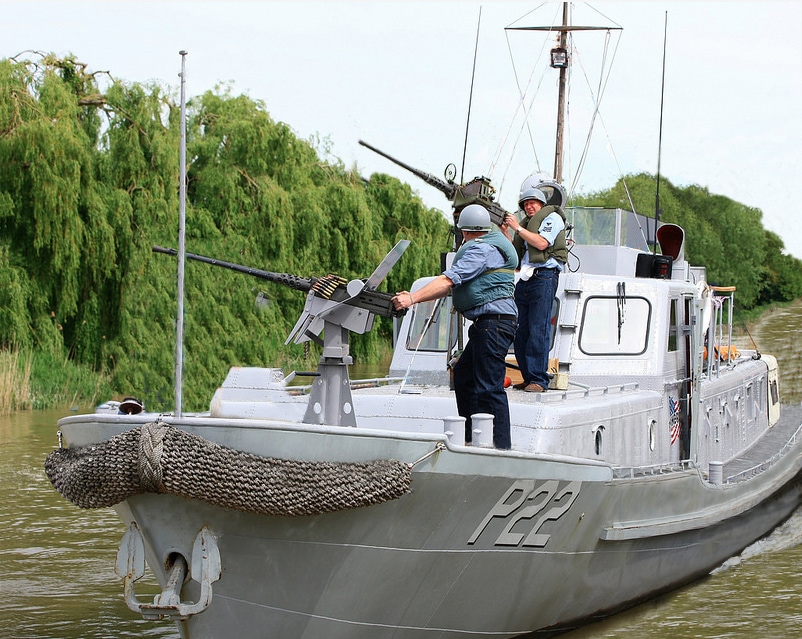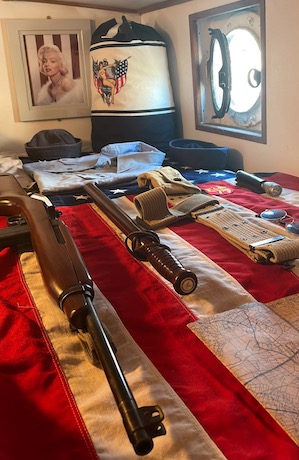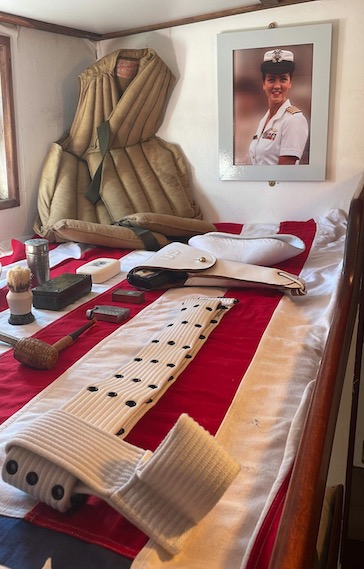Virtual Tour
Explore P22 in its historical context after WWII
The P22 is a type 21 fast patrol boat. At the end of World War II, with the Allies occupying the West German section this created the Cold War scenario with the Russian sector. The river Rhine, being the main route for shipping, and having Soviet presence on the east bank, cargo shipping had to be inspected for destination security.
The Allies decided the Rhine should carry out these procedures by having three stations on the Rhine. With German steelworks now under Allied control, the American Admiralty submitted plans for 21 of these vessels to be built to American specifications and design.
They commissioned the steelworks at Hizler in 1952 to undertake this task to add to the flotilla of vessels to monitor the 320 miles of the River Rhine. Seven vessels were given to the French, 7 to the English and 7 to the Americans.
These were based at three ports on the river Rhine - Mannhein, Karlsruhe and Mainz. These vessels were all financed by the United States to help rebuild the economy in Germany after its collapse in the Second World War.
As far as we are aware, the P22 is the only one remaining of the 21 vessels built. She has a steel hull and an aluminium superstructure, is 80 feet long, 12 feet wide and - with a crew of 6, water, fuel and ammunition - she weighs roughly 30 tons fully laden.
The P22 is powered by two Straight 8 Deutz Turbo Diesel engines connected to 2 driveshafts, making her a twin prop. In her days she was capable of roughly 27 knots, going with the tide she would probably be able to make 30 to 32 knotts.
You can read more about the Rhine River Patrol here (usarmygermany.com).

The Tour
Captain’s Quarters
As you descend the ladder from the top deck you make your way to the captains working quarters. This is where he would’ve performed his duties of the day, such as work logs, navigational chart adjustments and the general running of the vessel. Any infractions that occurred on the river Rhine during his duty would’ve been written up in the daily log which would then be handed in to the nearest port he would attend.
This area, although being a working area, could also be transformed into sleeping quarters for the captain. During the day, a flat surface would have been folded down to form a desktop, and once work had finished, it would then be lifted up, pinned in place with catches, and a bed would be underneath the work surface.
From here we can pass the head and the galley into the engine room.
Engine Room
On show and still operational are the original engines that were installed when the P22 was built in 1952. They are German Straight 8 Deutz Turbo diesel engines, powering twin propeller shafts to achieve the 27 knots. They are both water-cooled engines, but not oil fed. This means when both units are running, they have to be manually oiled and tappets adjusted. This is a very hot and noisy task as to do this the rocker covers have to be removed while cruising.
We try to operate both the engines given their age, the same hours. So one side would idle while the other one is at power and then we would swap over and do the same to the second unit. Most of the time, we would power both units equally, but reduce the rpm.
The starting procedure for the engines is exactly the same as you would have on a lorry or a car. You would switch the engine on to prime the heater plugs and when at the right temperature the igniter switch. The fuel capacity on the vessel is 1000 L of marine diesel which is 220 gallons in total. This, to give you some comparison, would get you to Normandy and the D-day beaches and back with a little bit to spare. We also carry on board 500 L of fresh water which is about 110 gallons for the crew to wash and drink. With the power output of both engines, she was designed for both river and seagoing capability.
Our last surveyor’s report states that the P22 is as strong and fit now as she was when she was first commissioned by the US Navy over 70 years ago. A credit to both the design and workmanship of this magnificent craft.
The Bunkhouse
These are the sleeping quarters for the six crew that would’ve been on the P22. As explained earlier, the captain also had his private quarters, but he did also have a bunk here in the bunkhouse. The officers would have had the single bunks, then the lower ratings would have had lower bunks and the cadets would have had the top two bunks.
Most of them would be allowed to bring personal, but limited items with them such as pictures of their wives, their family or their girlfriends. A lot of the guys had pictures of Hollywood actresses which they would place above the bunks. A lot of the crews on the American vessels took baseball and glove as well as footballs. These were allowed on board the vessel, so if you had a bit of free time you could play catch.
On display, you will also see items of kit that would’ve been issued for the purpose of your duty. Also on show is a 1942 lifejacket made of kapok – a buoyant plant-based material stuffed on the inside of a vest. If you look at another bunk, you will see a gas-powered version which was used later in the war. You would have also been issued a gas mask.
You would also have a webbing belt with a wooden baton, a holster and a 1911 Colt 45 pistol – this weapon would be in your possession for your entire duty.
Each of the bunks is covered in a 48 star American flag. This would have been given to them by their family to keep them safe while they were away from home.
Uniforms
There were three uniforms, worn by the crew of the P22. The first uniform was called day work wear, it would have been a blue chambray shirt with blue denim jeans, bellbottoms, a Dixie cap and rough out boots. This was day-to-day workwear on board the vessel.
The other uniform worn on board was called “Crackerjacks’. This was used for ceremonial purposes and was classified as your best uniform. The design for the uniform goes all the way back to the 1700s when the British were the biggest Navy in colonial times, and the Americans took a lot of the traditions and uniforms from the British as they were the most powerful navy in the world at the time. In 1748, the US Navy adopted the colour blue as their national colour by order of the secretary of the Navy.
The uniform is a two-piece and the design of the uniform is very specific. The jumper has a flap on the back which was used to stop grease and tar going onto the back of your uniform because back in the early days most sailors had long hair. The three stripes that are on the back of the flap and on the cuffs depict the three great sea battles of Nelson at Copenhagen, the Nile and Trafalgar.
The black neckerchief or silk that you would wear with this uniform was also used as a sweat rag and a tourniquet if injured in battle. Legend has it that the black silk scarf was actually introduced as a symbol of mourning for Admiral Lord Nelson when he was killed in battle, but this hasn’t been verified.
The Dixie hat also has a long tradition; this was made from torn sail material. It was much lighter than wearing normal hats which were wide-brimmed. The hat was colour coded and used to identify your role whilst on ship.
The trousers are also manufactured from the same type of cotton. When the cotton gets wet the material swells and this can hold air, so if a sailor falls overboard without a life vest, they can quickly remove the trousers without taking off the footwear and grab the end of the legs which will form a buoyancy aid.
The last two items to adorn the uniform are the stars on the back of the flap of the tunic. The nautical star is a symbolic star associated with sea services of all navies around the world. The five points represent protection, guidance, good luck and the ability in finding one’s way home, if lost in life and travel.
The third uniform on show is what they call tan uniform, this was worn by officers.
Bow Section
In the bow section of the vessel, we have a prison, food store and an ammunition store. It seems really strange that you would put a prisoner in with the food and ammunition, but everything would have been in locked metal boxes, so they could only be used to sit on.




